A compilation of cutesy crisp copy
Does anyone remember the old Seabrook’s crisps bag? It carried the immortal slogan:
“MORE” THAN A “SNACK”
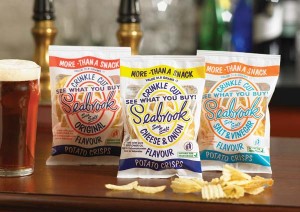 Very much stet on those bizarre scare quotes, which took a terrible cliché and plunged it into post-structuralist uncertainty. Just what was being queried about the ‘more’ and the ‘snack’? Could something be allegedly or possibly ‘more’ than something else, and in what sense? And what dimensions of ambiguity, allusiveness or irony did a snack take on once it was in quotes? (Sadly, as you can see, I can only find an image of a later version of the slogan, with a misspaced hyphen between ‘more’ and ‘snack’ – hardly an improvement.)
Very much stet on those bizarre scare quotes, which took a terrible cliché and plunged it into post-structuralist uncertainty. Just what was being queried about the ‘more’ and the ‘snack’? Could something be allegedly or possibly ‘more’ than something else, and in what sense? And what dimensions of ambiguity, allusiveness or irony did a snack take on once it was in quotes? (Sadly, as you can see, I can only find an image of a later version of the slogan, with a misspaced hyphen between ‘more’ and ‘snack’ – hardly an improvement.)
Seabrook’s has updated its packaging now, adopting the questionable slogan ‘a right proper gobful’, but it’s still way off the pace in terms of crispy copy. The plethora of ‘healthy/real’ crisp brands that have bobbed up in the wake of Kettle Chips have ladled an unbelievable amount of funky tone of voice on top of what’s essentially a commodity product. With almost nothing to choose between their product and a competitor’s, boutique crispsters look to their copywriters to give their products an air of fun, character and authenticity with some winning packaging copy. So let’s rip open the word bag and grab a handful…
Kettle Chips
We like to keep things simple…
We always insist on using the best potatoes we can find, hand cook them with care in small batches, then season with great tasting ingredients.
So what you get are naturally crunchy and tasty chips, each one a little different from the last.
There’s no need to add anything artificial – MSG, artificial flavours, colours and the like. And that’s the way it’s been for 25 years.
Simple really.
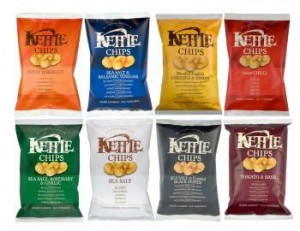 The daddy of ‘real’ crisps establishes a theme we’ll see in many competitors – the alleged quest for the ‘best’ potatoes and other ingredients.
The daddy of ‘real’ crisps establishes a theme we’ll see in many competitors – the alleged quest for the ‘best’ potatoes and other ingredients.
Kettle Chips make a play on authority here, citing the 25 years they’ve been in the authentic-crisp game, man and boy. Does that convince the reader? Possibly, but in most contexts I advise clients that the date of foundation for the company is of marginal interest to their customers. If the crisps taste good, I don’t really care if you started up yesterday.
A few technical observations. Personally, I’d have put a hyphen in ‘hand cook’ and ‘great tasting’. I’d have found a way to rephrase ‘so what you get are’, to avoid the jarring singular/plural juxtaposition. And I’d have avoided saying ‘artificial’ twice in the space of three words.
In terms of tone, it’s all very self-centred. What about my enjoyment, my mood, the value I get from the product? I’m only tangentially involved in this whole deal. But as we’ll see, smug self-absorption is very much the order of the day in this sector.
Red Sky
A red sky at night is nature’s promise of a good day.
Red Sky potato chips are our promise of something good from nature.
We only use the best ingredients from nature’s kitchen to bring you these beautifully crunchy potato chips which taste as good as you would expect from 100% natural ingredients.
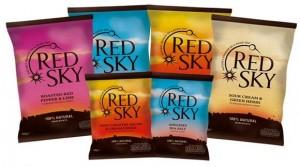 Grammar: there should be a comma after ‘chips’ in the last sentence.
Grammar: there should be a comma after ‘chips’ in the last sentence.
I must admit, I quite like the cheesy play on the brand name (‘promise of something good’). I’ve written before that a slogan should promise value, and making that explicit is quite nice. However, some might find the tone here a bit pious.
The final paragraph is a bit clunky, stumbling around in a circle to where it began with the ‘natural ingredients’ riff. I might have got rid of this last bit in a spirit of ‘less is more’ – the first two bits imply ‘good ingredients’ without needing to wheel out the ‘100% natural’ guns. And as we’ve seen, this theme is hardly original.
Burt’s Chips
A big hello from all the fryers at Burt’s!
In 1997 all we could find were tasteless, junk-filled crisps. We knew we could do better. After a lot of searching we found an old fryer (a machine not a person) and put it in a tiny factory down here in deepest Devon. We then started to work out how to make fantastic chips using only the finest and freshest natural ingredients.
It took us ages to cook the perfect chip with quite a few burnt ones (and fingers) along the way. Eventually we worked out a simple and delicious recipe. Our chips are crunchy, natural and full of flavour – just as they should be. The most naturally delicious chips you have ever tasted.
The ‘tasteless, junk-filled crisps’ of 1997 presumably include Burt’s rival Kettle Chips, who (as we’ve seen) had been going for a decade at that point.
In the hands of challenger/premium crisp brands, this ‘rural quest for perfect crisp’ tale has actually become a cliché. Its weak point, as far as I can see, is the audience not really giving a toss about the fryer, or the factory, or the whole dreary burnt-out-stockbroker-starts-boutique-business-somewhere-not-London narrative. However I must grudgingly admit that ‘good origin’ does seem to play on consumers’ minds – middle-class, recession-immune consumers’ minds, anyway.
The tone is quite interesting. It’s a sort of sub-Innocent, faux-naïf voice that’s used in different forms by lots of these ‘real’ brands. In terms of meaning, it positions the whole Burt’s enterprise as a sort of happy-go-lucky, kitchen-table affair where success, well, just kinda happens to nice people. In fact, Burt’s cottage-operation days are long gone – but the homely connotations suit the brand even as its executives talk turkey with Tesco’s.
Note the recurrence of the ‘only the best ingredients’ jive once again. Although the theme no longer offers any differentiation – they’re all using the best, apparently – premium crisp makers just can’t leave it alone.
(Perversely, all this ‘good origin’ stuff makes me want to pig out on the low-rent snacks made with all the crapola Class B spuds. I bet they’re fantastic. In the same way, Green & Black’s po-faced preening sends me running for the Dairy Milk.)
Real Crisps
When it comes to crisps, we don’t mess about. Oh no. We pick out the best potatoes and hand cook them, so the goodness stays put. No nonsense. Just delicious real crisps – like these, sprinkled generously with sea salt. And you don’t even need your sea-legs to enjoy them.
Best potatoes, delicious, yawn. Not much new here in terms of the content.
Technically, why is ‘hand cook’ two words when ‘handcooked’ is one word on the front of the bag? (See image.) Poor, unfashionable hyphens, we’ll miss you when you’re gone.
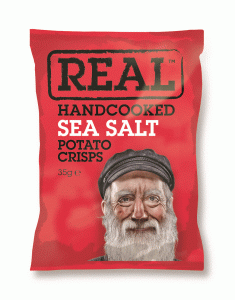 Tonewise, we’re striking out even further into Innocent territory – ‘Oh no’, ‘no nonsense’. What is this tone of voice? Tentatively, I identify it as the voice of the middle-class parent: shrill, desperate jollity thinly masking an undercurrent of snobbishness, control-freakery and passive aggression. The sound of an adult talking to a child, or trying to sound like a child, or irritating anyone who isn’t a child by being so overbearingly twee and patronising. With posh crisps, we’re hearing a ‘cool’ but nonetheless authoritarian parent telling us we really should be eating proper snacks instead of those nasty orange Wotsits. Mm?
Tonewise, we’re striking out even further into Innocent territory – ‘Oh no’, ‘no nonsense’. What is this tone of voice? Tentatively, I identify it as the voice of the middle-class parent: shrill, desperate jollity thinly masking an undercurrent of snobbishness, control-freakery and passive aggression. The sound of an adult talking to a child, or trying to sound like a child, or irritating anyone who isn’t a child by being so overbearingly twee and patronising. With posh crisps, we’re hearing a ‘cool’ but nonetheless authoritarian parent telling us we really should be eating proper snacks instead of those nasty orange Wotsits. Mm?
The last sentence is interesting: a joke that doesn’t make you laugh. (OK, it links in with the picture of a fisherman on the front of the packet, but still.) Why use unfunny humour? One answer is that it’s mandatory for the would-be ‘funky’ brand, so the copywriter goes for the cover drive even if the ball just isn’t there to be hit (see Burt’s lame ‘fryer’ pun above). Another answer is that the humourless lack insight into their own humourlessness.
I always advise my clients never to write something they would not feel comfortable saying to a customer, face to face. I’m not sure this copy passes that test. Who’s talking here, and to whom? And why? (Answers: A. A marketer; B. Themselves; C. To ‘build a brand’.)
Be yourself
As you’ll have guessed, I sampled all these products in the course of researching this post. I have to report that, to my uncouth palate at least, they’re all pretty much the same. So it’s not a surprise that they’ve reached for content and tone of voice as means of differentiation.
What is surprising, arguably, is that they’ve all ended up with broadly the same messages. In place of any allusion to the consumption occasion (when you eat the crisps), the mood of the consumer or anything else we could identify with, we’ve got the same old ‘good ingredients’ thing across the board. Is there nothing else to say?
I’d also argue that the tones used are pretty uniform, with the possible exception of Red Sky. While tone of voice as a concept has value, its practitioners will lay themselves open to ‘emperor has no clothes’ charges if they just end up copying Innocent or Apple, using the same tools regardless of the job at hand.
In my experience, every brand really does have a narrative and every company really has a unique character. The brands who find genuine differentiation are the ones with the guts to be themselves.
Comments (9)
Comments are closed.
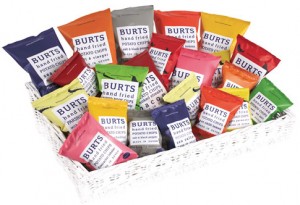
You know what the worst thing about all of that copy is?
One single, solitary misused word.
“Chips”
A crisp is not a chip, damnit. Using a foreign term for a mundane product doesn’t make that product exotic. It makes the writer sound pretentious.
Good post Tom. I admire your thorough research into the crisp market.
That Kettle Chips copy has always bugged me – I’ve come close to blogging about it before. (I obviously eat too many Kettle Chips.) For me, it perfectly sums up the misplaced obsession brands have with ‘simplicity’.
Look at those first two paragraphs:
“We like to keep things simple…
We always insist on using the best potatoes we can find, hand cook them with care in small batches, then season with great tasting ingredients.”
It’s a direct contradiction.
There’s absolutely nothing simple about sourcing the best potatoes, hand-cooking them in small batches and then seasoning them with great-tasting ingredients.
It would be much simpler to use any old potatoes, cook them in vast quantities on an automated production line and then season them with any old shit.
By taking care over what they do, Kettle Chips are actually making the whole process more complicated. And that’s a good thing. The customer is paying for that complexity. They should celebrate it, instead of pretending it’s simple.
Instead, we get all this ‘Simple, really’ guff. Like saying something is simple makes it so.
With all this in mind, I will shortly be launching a range of hand soaps and toiletries called ‘Really f–kng complicated’.
If you’re interested to see what New Zealand copywriters have to say on the subject, I’ve just retrieved a bag of Bluebird Light Plus chips (fine, fine, Andy, crisps) from my cupboard. Bluebird is a major company that produces a huge range of crisps in this country. You could probably compare it to Walker’s.
—
Light and delicious!
Light Plus potato chips are cooked in sunflower oil for people wishing to maintain a healthier lifestyle.
Why Light Plus?
– Reduced fat
– 85% less saturated fat
– Cooked in sunflower oil
Made with the finest New Zealand potatoes, cooked in sunflower oil to create a fresh, delicious taste with a reduced fat benefit.
Enjoy!
—
I think we can all agree that at least these UK copywriters have gone to some effort. Where is the personal tone? Where is the grammar in the last part? Why have they stated almost the same fact twice in the bullet points? Could they not think of a third good thing about the product? Why do they feel the need to mention THREE TIMES that the crisps are cooked in sunflower oil? (And just in case you missed it, there are two pictures of sunflowers on the back of the packet.) Oh, and the bullet points also appear on the front of the packet, so yay, less work to do!
I suppose this passes the ‘would you say it to a customer’s face?’ test, but I think the customer’s eyes would glaze over by the time the spiel was over.
@Andy – Yes, I agree. Going to market with a product name that EVERYONE uses to describe something else (i.e. proper chips, that go with fish) is unbearably precious.
@Nick – You’re right. It isn’t simple. It’s like they wanted simplicity to be the theme, but couldn’t marry it with the facts they had. ‘Purity’ might have worked better. But what’s wrong with tasty?
@Lucy – That really is weak. I think there’s some OK copy in there struggling to get out, but as you say a lot of repetition needs to be excised before it can breathe. And the bullet point list, which limps to make three points by repeating one, is a complete non-starter. ‘Maintain a healthy lifestyle’ surely could have been ‘live healthy’. The ‘Enjoy!’ at the end, though unoriginal, is probably the best bit.
Great blog, as always.
Personally I’d say they need to have the guts to be different, rather than themselves. Because, for all we know, perhaps they are already being “themselves”. They might indeed all live for finding the best potatoes, hand-cooking (or handcooking) them, and whatnot.
How quickly we all fall into perceived idiom? To be different, you have to say more than “We’re different!” …and then proceed to roll-out a lot of similar-but-different stuff to your nearest competitors. Clearly a subject for more research though.
[…] Tom at ABC Copywriting wrote a great comparative post about chips (oh ok, ‘crisps’), which provided a valuable lesson about being yourself in business: A Compilation of Cutesy, Crisp Copy […]
I remember working on scripts for the launch of the then-new crisp product, McCoys. One script had earthy, 19th century American frontiersmen producing the crisps from implausibly new stainless steel equipment. The line was ‘McCoys. Made the old-fashioned way for well over six months.’
The client didn’t buy it. The client didn’t even get to see it. This was the 80s, and irony was yet to be invented.
#crispscripts
Sounds like a winner to me.
The brand definitely has connotations of that period (shades of Phileas Fogg, actually), but I’m interested that you located it geographically in the US.
To the extent that I’m conscious of it, which is not hugely, I’ve always thought of McCoy’s as being cod-Celtic, either Irish or Scottish, but definitely this side of the Atlantic.
Looking on Wikipedia, the origin of ‘real McCoy’ as a saying is unknown, with plausible accounts from Scotland, Canada and the US – but it brings a distinctly 19th-century manly moustache vibe regardless.